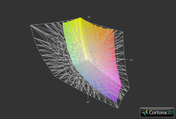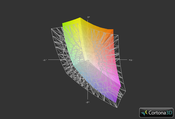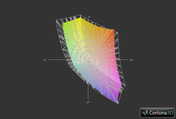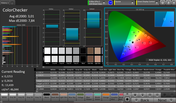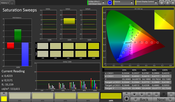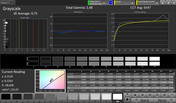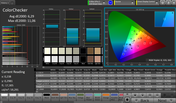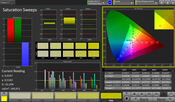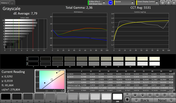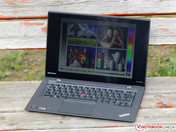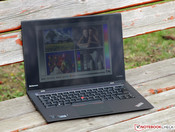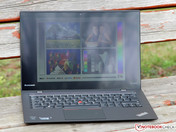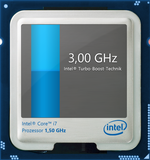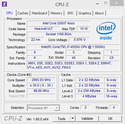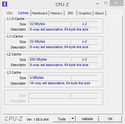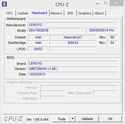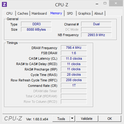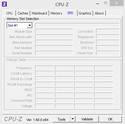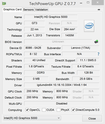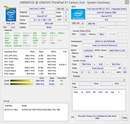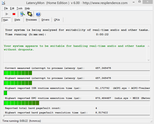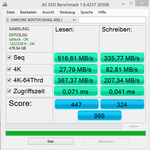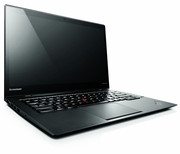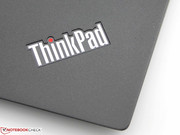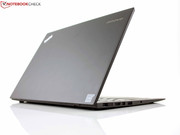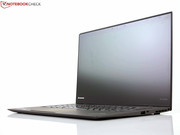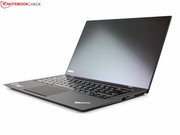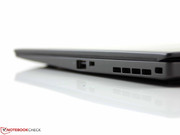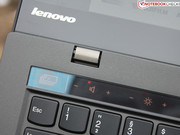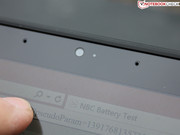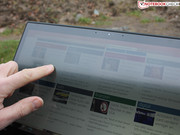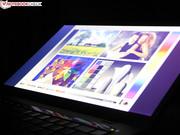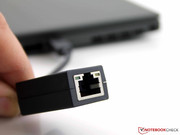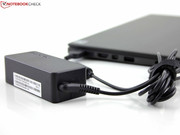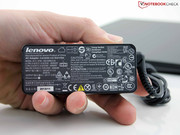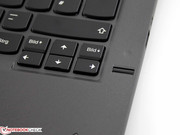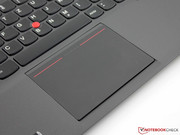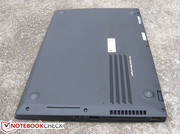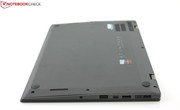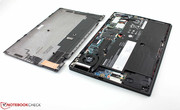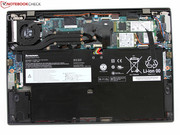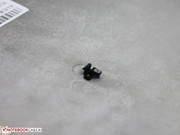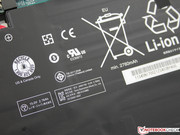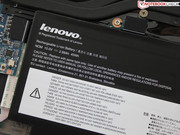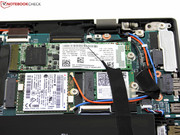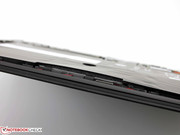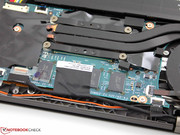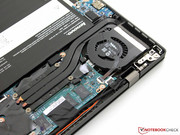Review Update Lenovo ThinkPad X1 Carbon Touch 20A7-002DGE Ultrabook

For the original German review, see here.
Lenovo certainly can't be accused of lacking innovation. The X1 Carbon was one of the first Ultrabooks designed for business customers looking for a sleek alternative to a "normal" ThinkPad.
A few weeks ago we subjected the second generation of the Ultrabook to our stringent battery of tests. The ThinkPad didn't convince in all areas - namely the input devices, which have been revised yet again, polarize opinions. Although the user doesn't have much of a choice in this area, Lenovo at least offers several different hardware configurations.
For this review update, we are taking a look at the top-of-the-line version, which sells for around 2000 Euro (~$2800). The CPU - an Intel Core i7-4550U - comes with the integrated HD Graphics 5000 instead of the more common HD Graphics 4400, which should improve the 3D performance. In addition, the Ultrabook ships with a generous 8 GB of RAM and a 512 GB SSD. All other specs are identical to our previous review model, so we will focus mainly on the differences in performance.
| ThinkPad X1 Carbon (20A70027GE) | ThinkPad X1 Carbon (20A7005MGE) | ThinkPad X1 Carbon (20A7002DGE) |
|---|---|---|
| Core i5-4200U | Core i5-4200U | Core i7-4550U |
| 4 GB RAM | 8 GB RAM | 8 GB RAM |
| 128 GB (SSD) | 180 GB (SSD) | 512 GB (SSD) |
| HD Graphics 4400 | HD Graphics 4400 | HD Graphics 5000 |
| 14", 2.560 x 1.440 Pixel | 14", 2.560 x 1.440 Pixel | 14", 2.560 x 1.440 Pixel |
| kein WWAN | UMTS/HSDPA/HSPA+ | UMTS/HSDPA/HSPA+ |
| ab 1.300 Euro | ab 1.600 Euro | ab 2.000 Euro |
Display
The X1 Carbon has two display options: the entry-level model ships with a TN panel and WXGA resolution (1600 x 900 pixels and 131 dpi - not available in all markets); our review model is equipped with the a touchscreen IPS panel and WQHD resolution (2560 x 1440 pixels, 210 dpi). We already reviewed this particular panel, so this time around, we are just going to check for possible variations within the panel series.
And indeed: with an average brightness of 226 cd/m², the display is darker by yet another 10 % when compared to the previous review model (252 cd/m²), which was not bright enough in our opinion. After all: Lenovo promises 300 cd/m² and the competitors Dell Latitude E7440 (302 cd/m²) and Fujitsus Lifebook U904 (306 cd/m²) are quite a bit brighter. The ThinkPad is suitable for working inside without major restrictions, but outdoor usability definitely suffers as a consequence.
| |||||||||||||||||||||||||
Brightness Distribution: 89 %
Center on Battery: 228 cd/m²
Contrast: 991:1 (Black: 0.23 cd/m²)
ΔE ColorChecker Calman: 6.29 | ∀{0.5-29.43 Ø4.78}
ΔE Greyscale Calman: 7.79 | ∀{0.09-98 Ø5}
51.7% AdobeRGB 1998 (Argyll 1.6.3 3D)
55.2% AdobeRGB 1998 (Argyll 3D)
77.5% sRGB (Argyll 3D)
54.1% Display P3 (Argyll 3D)
Gamma: 2.36
CCT: 5531 K
The contrast ratio of 991:1 is also lower when compared to the previous review notebook (1434:1). This is less important than the possible maximum brightness, so we won't complain too much here - good IPS panels (in this case: LG Philips LP140GH1-SPA2) usually have ratios of about 1000:1, which pretty much guarantees a vivid and saturated picture. Compared to a cheaper TN display, the much deeper blacks are especially apparent - although we also noticed light bleeding at the bottom of the panel.
The fairly low coverage of the professional color spaces notwithstanding, the panel is suitable for photo and graphics editing - provided it is calibrated first. The Delta E deviations drop to about 3.0 and the gray levels are close to the reference ideal at a Delta E of only 0.75. As always, the corresponding ICC profile can be downloaded (right next to the graphic showing the brightness distribution).
Although Lenovo touts a touchscreen with anti-glare properties, the display is nonetheless fairly reflective. Especially outdoors, the combination of low brightness and glare lowers the readability, so the user should seek shaded areas if at all possible. The semi-matte display of the X1 Carbon still outperforms a similarly bright glossy panel, however.
While TN panels react to even smaller head movements with a deteriorating picture quality, displays with IPS technology exhibit a much better viewing angle stability, although differences in quality are noticeable as well: in the vertical plane, angles of above 30 degrees result in a slightly lower brightness and subtle color changes. Some competitors do a better job here, although the display of the review notebook still outperforms any TN panel on the market.Review Samsung ATIV Book 9 Plus 940X3G Ultrabook
Performance
The base frequency of only 1.5 GHz of the Core i7-4550U might cause some raised eyebrows at first - after all, even the less expensive Core i5-4200U has a clock speed that is higher by 100 MHz. The Turbo levels of 2.7 GHz (both cores) and 3.0 GHz (single core) of the i7-4550U are comparable to the family member Core i7-4500U, however. The only difference between the two: while the 4500U ships with the integrated HD Graphics 4400, the 4550U comes equipped with the faster HD Graphics 5000. The higher maximum power consumption of the graphics card is responsible for the difference in the base frequency of the CPU section. Like all Haswell processors, the i7-4550U is manufactured using a 22 nm process. The ULV CPU is designed with a TDP of only 15 watts.
One of the main reasons for the very high sticker price of our configuration is the SSD, which features a capacity of 512 GB and uses the modern M.2 interface (SATA 6.0 Gbps). Also noteworthy are the 8 GB of system RAM, which is sufficiently large: since the RAM is soldered onto the motherboard, a later expansion is not possible.
Processor
In order for current-generation processors to develop their full power potential, the Turbo has to reach maximum levels - something theReview Lenovo ThinkPad X1 Carbon Touch 20A8-003UGE Ultrabook X1 we reviewed previously had issues with. It seems that Lenovo was able to correct the problem: the Core i7-4550U is now able to reach its maximum clock speed. During single-threaded benchmarks like SuperPi, the CPU reaches the maximum of 3.0 GHz and is able to maintain it. Multi-threaded tests, like the Cinebench R15, the processor handles at 2.7 GHz initially; after about 30 seconds, the clock speed drops to 2.5 GHz in order to maintain the TDP. The notebook behaves identically when running on battery.
The performance of the i7-4550U is equivalent to the already mentioned i7-4500U, so the lower core frequency is not a reason for concern. Notebooks this size don't really offer higher performance, as the following comparison shows.
Storage Devices
Lenovo designed the X1 to be as light as possible and uses compact M.2 SSDs for that reason. Our review model ships with the Samsung MZNTD512HAGL, which appears to be a modified Samsung PM841 adapted for the mSATA interface. The transfer protocol is the normal SATA standard with speeds up to 6 GB/s, which means that the new form factor does not offer a performance benefit (note that M.2 drives can also interface using PCI Express technology - but only very few models make use of it)
Our suspicion that the SSD might be related to the PM841 is confirmed when we take a look at the benchmark results, which are nearly identical to the latter. Sequential read speeds top out at 517 MB/s and are thus approaching the limit of the SATA interface; the write speed (which, unlike for Sandforce-based SSDs, does not depend on the compressibility of the data) is also quite good at 336 MB/s. Although the drive cannot keep up with high-end models like the Samsung SSD 840 Pro as far as the 4K test results are concerned, the overall performance is quite impressive.
System Performance
As expected, the fast hardware results in good benchmark scores as well as in very good perceived performance. With 5312 points for the PCMark 7 test, the X1 Carbon outperforms the ThinkPad T440s (5022 points) as well as the Fujitsu Lifebook U904 (4825 points), even though both of these notebooks ship with the slightly more powerful Core i7-4600U. The pretty substantial performance deficit of the different configurationReview Lenovo ThinkPad X1 Carbon Touch 20A8-003UGE Ultrabook we tested a few weeks ago doesn't indicate the real performance potential and seems to be the result of a measurement error.
Everyday performance is swift thanks to the fast SSD, which allows for quick system boots, program starts, and installations. The processor also contributes as well and not only handles office programs and Internet applications, but also more demanding software and multitasking with surprising ease.
| PCMark 8 - Home Score Accelerated v2 (sort by value) | |
| Lenovo ThinkPad X1 Carbon Touch 20A7-002DGE | |
| Lenovo ThinkPad X1 Carbon Touch 20A8-003UGE | |
| PCMark 7 Score | 5321 points | |
| PCMark 8 Home Score Accelerated v2 | 2981 points | |
| PCMark 8 Creative Score Accelerated v2 | 3248 points | |
| PCMark 8 Work Score Accelerated v2 | 3802 points | |
Help | ||
GPU Performance
How is the HD Graphics 5000 different from the HD Graphics 4400? Both are integrated into current Haswell ULV CPUs, but the HD 5000 has twice as many shader units (40 instead of 20 EUs). Users expecting the 3D performance to increase by the same margin will be disappointed: in many cases, the performance is limited by the RAM interface and the HD 4400 quite frequently maintains a higher clock speed - a function of the lower ALU-number in conjunction with the same TDP-rating.
The net result is that the HD 5000 - depending on the benchmark - only has a marginal advantage as far as its performance is concerned. For the 3DMark Fire Strike test, for example, the X1 Carbon performs on par with the fastest HD 4400-class notebooks; for the CAD benchmark SPECviewperf 11, the HD 5000 is about 15 - 20 % faster. Those needing to use construction software like Catia are better off with a professional GPU like the AMD FirePro M4100, which, thanks largely to an optimized driver, is faster by a factor of 6.
The Intel GPU is of course suited very well for normal office and multimedia tasks and even 4K videos play smoothly and with low CPU utilization. Other useful features of the integrated graphics are the very efficient Quick Sync Transcoder or the OpenCL support (for example used to accelerate various filters in Photoshop).
| Lenovo ThinkPad X1 Carbon Touch 20A7-002DGE HD Graphics 5000, 4550U, Samsung MZNTD512HAGL | Lenovo ThinkPad X1 Carbon Touch 20A8-003UGE HD Graphics 4400, 4600U, Intel SSD Pro 1500 Series SSDSCKHF240A4 | Fujitsu Lifebook U904 HD Graphics 4400, 4600U, Toshiba HG5d THNSNH256GCST | HP ZBook 14 FirePro M4100, 4600U, Samsung SSD 840 Pro 256GB MZ7PD256HAFV-0Z000 | |
|---|---|---|---|---|
| SPECviewperf 11 | -13% | -20% | 580% | |
| 1920x1080 Siemens NX (fps) | 1.26 | 1.15 -9% | 1.06 -16% | 21.28 1589% |
| 1920x1080 Tcvis (fps) | 1.77 | 1.62 -8% | 1.47 -17% | 13.56 666% |
| 1920x1080 SolidWorks (fps) | 7.95 | 6.77 -15% | 6.04 -24% | 37.88 376% |
| 1920x1080 Pro/ENGINEER (fps) | 1.42 | 1.39 -2% | 1.72 21% | 8.87 525% |
| 1920x1080 Maya (fps) | 12.95 | 10.69 -17% | 7.81 -40% | 37.65 191% |
| 1920x1080 Lightwave (fps) | 13.34 | 10.81 -19% | 9.88 -26% | 48.54 264% |
| 1920x1080 Ensight (fps) | 2.06 | 1.58 -23% | 1.29 -37% | 11.29 448% |
| 1920x1080 Catia (fps) | 25.05 |
| 3DMark 06 Standard Score | 6160 points | |
| 3DMark Vantage P Result | 3981 points | |
| 3DMark 11 Performance | 1048 points | |
| 3DMark Ice Storm Standard Score | 35290 points | |
| 3DMark Cloud Gate Standard Score | 4360 points | |
| 3DMark Fire Strike Score | 658 points | |
| 3DMark Fire Strike Extreme Score | 305 points | |
Help | ||
Gaming Performance
The HD Graphics 5000 handles current games only at lower settings, but for some games (Metro: Last Light, Company of Heroes 2) even the lowest settings don't guarantee acceptable frame rates. Older and less GPU-intensive titles are playable at higher settings, although even Fifa 14, which is known to not be demanding at all, can't be played at the native resolution of 2560 x 1440 pixels. Full-HD interpolation, on the other hand, offers very good quality.
| low | med. | high | ultra | |
|---|---|---|---|---|
| The Elder Scrolls V: Skyrim (2011) | 29.5 | 18.4 | 11.6 | |
| Call of Duty: Black Ops 2 (2012) | 40.5 | 28 | 14.1 | |
| Metro: Last Light (2013) | 18.9 | 13.9 | 10.4 | |
| GRID 2 (2013) | 58.6 | 31.3 | 22.7 | 12.5 |
| Company of Heroes 2 (2013) | 13.3 | 10.4 | 6 | |
| Dota 2 (2013) | 59.6 | 31.5 | 15.5 | |
| Total War: Rome II (2013) | 39.8 | 29.4 | 21.6 | 6.6 |
| Fifa 14 (2013) | 165.1 | 100.2 | 71.4 | 39.3 |
| F1 2013 (2013) | 51 | 34 | 28 | 12 |
| Battlefield 4 (2013) | 28.6 | 19.9 | 13.3 | |
| Call of Duty: Ghosts (2013) | 24 | 20.5 | 6.2 | |
| Thief (2014) | 11.9 | 8.4 | 7.6 | 3.9 |
| Titanfall (2014) | 33.2 | 20.2 | 13.2 |
Emissions
System Noise
The X1 Carbon is not only completely silent during idle, but also when handling many mainstream tasks. The single fan - the only source of noise since there is no mechanical hard drive - is turned off during those scenarios. Many competitors are also passively cooled when the power output is low - see for example Fujitsu's Lifebook U904.
When the CPU or GPU are tasked more heavily, the little fan spins up and produces a faint whooshing sound. Even when pushed to the limit, the notebook never gets really loud: we measured only 34 dB(A) during our stress test. The emitted frequencies are easy on the ears and we didn't notice any other distracting sounds during our review.
Noise level
| Idle |
| 28.8 / 28.8 / 28.8 dB(A) |
| Load |
| 33.7 / 34 dB(A) |
 | ||
30 dB silent 40 dB(A) audible 50 dB(A) loud |
||
min: | ||
Temperature
Even though the fan isn't very active for most of the time, the notebook doesn't get overly hot. During idle, we saw temperatures from 25 to 32 °C, under full load (Prime95 and FurMark) we recorded a maximum of 40 °C. The highest temperatures are restricted to the areas around the CPU location and next to the fan exhaust, however, and many parts of the chassis barely get lukewarm. Using the Ultrabook on the lap is possible without any restrictions.
Unfortunately, the Core i7-4550U is subjected to throttling in high-power scenarios. Lenovo is not at fault here, however: it is the low TDP that causes the CPU frequency to drop down to 800 MHz in some cases. The GPU consumes a lot of the available power and, with a frequency of 450 MHz, still makes uses of the Turbo to a certain extent (range is from 200 to 1100 MHz). There is no reason for concern as far as the possible temperature development during the height of summer is concerned: Intel designed the Core i7 for temperatures up to 100 °C - and during our stress test with Prime95 and FurMark, the CPU didn't really surpass 70 °C.
(±) The maximum temperature on the upper side is 40.2 °C / 104 F, compared to the average of 35.9 °C / 97 F, ranging from 21.4 to 59 °C for the class Subnotebook.
(+) The bottom heats up to a maximum of 38.8 °C / 102 F, compared to the average of 39.3 °C / 103 F
(+) In idle usage, the average temperature for the upper side is 27.6 °C / 82 F, compared to the device average of 30.8 °C / 87 F.
(+) The palmrests and touchpad are cooler than skin temperature with a maximum of 28 °C / 82.4 F and are therefore cool to the touch.
(±) The average temperature of the palmrest area of similar devices was 28.2 °C / 82.8 F (+0.2 °C / 0.4 F).
Speakers
The quality of the stereo speakers has remained unchanged since our last review. Positive aspects are a high maximum volume and the very clear highs, although the bass is lacking. The user can always connect external speakers or headphones, although we would recommend lower-impedance headphones: the maximum volume level was quite low when we connected our AKG K 701 (62 Ohm) headphones.
Energy Management
Power Consumption
Thanks to the very frugal Haswell platform, the ThinkPad has a minimum power requirement of only 4.1 watts. We had to deactivate the wireless modules and lower the display brightness all the way, which makes the screen content very hard to see and doesn't allow for a fair comparison with the competition. With the WLAN active and the brightness set to a comfortable level, we recorded a power consumption of 7 to 8 watts, which is about average for this class.
Under maximum load, the power needs surpass 30 watts for a few seconds before stabilizing at about 27 watts. The reason for this behavior is Intel's Turbo Boost, which temporarily exceeds the TDP to compensate for performance spikes. The included power adapter supplies 45 watts and has enough reserves to charge the notebook while it is running.
| Off / Standby | |
| Idle | |
| Load |
|
Key:
min: | |
Battery Life
The X1 Carbon is only available with the integrated battery with a rated capacity of 45 Wh, which - according to Lenovo - is good for run times of up to 9 hours. Tasked with the Battery Eater Reader's Test (power saver mode, minimum brightness, wireless off), the Ultrabook exceeded the manufacturer's claim and lasted for over 12 hours. This result of course does not reflect a likely usage scenario.
With the display brightness set to about 150 cd/m², the user can browse the web or watch HD videos for about 6 hours - a result comparable to the Fujitsu Lifebook U904 or the HP EliteBook Folio 1040 G1 (both are also equipped with 45 Wh batteries).
Since Lenovo doesn't artificially throttle CPU or GPU performance when the X1 is operating on its battery, the run time of 1 hour and 47 minutes we recorded for the Battery Eater Classic Test (high performance, maximum brightness, wireless on) falls a bit short of the times achieved by the competitors. A standout feature are the very quick charge times: after 60 minutes, the battery is 75 % full; one hour later, Windows reports a full charge.
Verdict
About 700 Euro (~$1000) separate the least and the most expensive version of the Lenovo ThinkPad X1 Carbon - a substantial amount of money, especially considering the high base price of 1300 Euro (~$1800). Even the base version - equipped with the Core i5-4200U - offers a speedy CPU, an SSD (128 GB), as well as the exceedingly sharp WQHD display. For most users, this model should suffice, since the X1 wasn't designed to handle workstation-class software in the first place.
The faster versions of the notebook make sense, too: especially the 8 GB of RAM are a good incentive (since the RAM is not user-upgradable), as are the larger SSD and the integrated WWAN module (worth about 100 Euro / ~$140). The performance increase offered by the Core i7-4550U is fairly marginal and not really noticeable during day-to-day use. The same is true for the integrated HD 5000 graphics card.
Aside from possible performance considerations, our overall assessment - see the previous review - remains the same. Lenovo has created a well-rounded Ultrabook which meets the general critera for build quality, value, input devices, and security features. A long battery life and low emissions are also added bonuses and help justify the rather steep price. The competition also offers compelling alternatives - please check our reviews of the Dell Latitude E7440, Fujitsu Lifebook U904 and the HP EliteBook Folio 1040 G1 for the various strengths and weaknesses of these notebooks.
Please note: this review follows the guidelines of our new rating system, which means that the final score is not necessarily comparable to previous scores.





